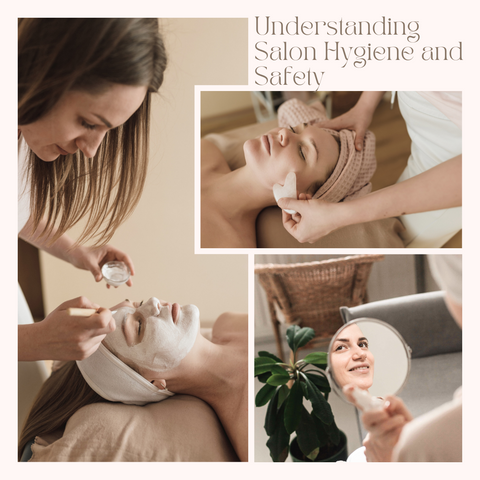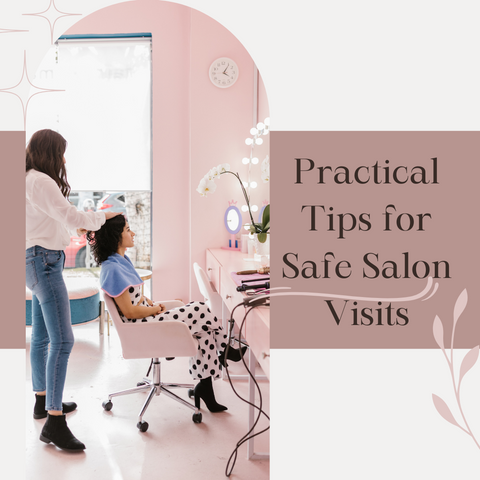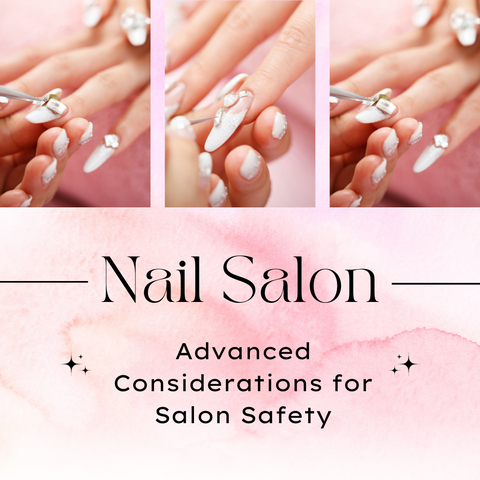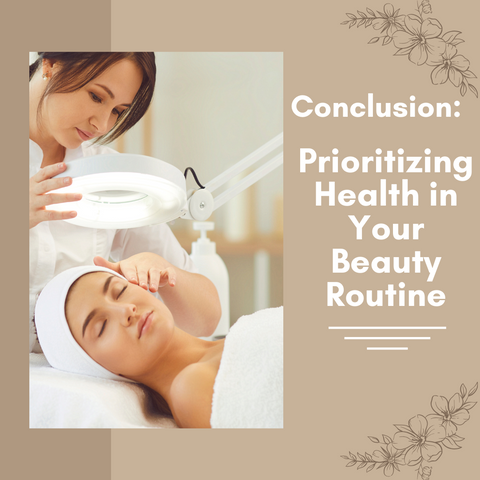Infection protection at beauty salons is critical for your health. This blog discusses crucial tips for reducing the risk of infection during salon visits.
Understanding Salon Hygiene and Safety

Understanding salon hygiene and safety is crucial for ensuring a safe and enjoyable experience. Here are key aspects to consider, such as cleanliness standards, staff training, tool sterilisation, single-use items, proper disposal, hand hygiene, clean linens and towels, no double-dipping, ventilation, professional appearance, client consultations, education and communication, emergency preparedness, regular inspections, display of licenses and certifications, client comfort and privacy, covid-19 protocols, and client feedback. By being informed and vigilant about hygiene and safety practices, both salon owners and clients contribute to a safe and enjoyable experience. Regular communication and adherence to industry standards are essential for maintaining high hygiene standards in beauty salons.
Importance of Salon Hygiene Practices
Salon hygiene practices are critical for several reasons, including the safety of both clients and salon employees. Here are some of the main reasons why salon hygiene is so important:
-
Prevention of Infections: Proper hygiene habits, such as regular cleaning, sterilisation of tools, and adherence to sanitary procedures, aid in the prevention of infection spread. This is especially critical in services where there is direct contact with the skin, such as manicures, pedicures, and waxing.
-
Client Safety and Health: Maintaining a clean and sanitary atmosphere is critical for guaranteeing customer safety and wellness. Clients should have confidence that the salon is dedicated to providing a risk-free experience.
-
Professional Reputation: A salon that is known for its cleanliness is more likely to attract and retain customers. Positive feedback and word-of-mouth are frequently dependent on the salon's cleanliness and safety.
-
Compliance with Regulations: Salons are required by law to adhere to hygiene standards. Compliance with health and safety regulations ensures that the salon operates legally and avoids legal ramifications.
-
Cross-Contamination Prevention: Proper sterilisation and disinfection practices help to prevent client cross-contamination. This is critical in reducing the risk of infection spread, including bacterial and fungal conditions.
-
Client Trust and Confidence: Clients are more likely to trust and have faith in a salon that prioritises hygiene visibly. A positive client experience is enhanced by knowing that their well-being is a priority.
-
Prevention of Skin Issues: Inadequate hygiene can result in skin problems, allergic reactions, or infections. A clean environment and proper product handling help to prevent skin problems.
-
Employee Well-Being: Maintaining hygiene standards is important not only for the benefit of clients, but also for the health of salon employees. Proper training and access to hygiene resources contribute to a safe working environment.
-
Long-Term Business Success: A salon's success is often tied to its reputation. The ability to establish a reputation for cleanliness and hygiene is critical to long-term business success and sustainability.
-
Prevention of Occupational Hazards: Salon workers may be exposed to various chemicals and substances. Adhering to safety and hygiene practices helps prevent occupational hazards and ensures a healthy work environment.
-
Product Contamination Prevention: Proper hygiene practices include the handling and storage of cosmetics. Contaminated products have the potential to cause adverse reactions and should be avoided.
-
Public Health Promotion: Salons contribute to overall public health by reducing the risk of infectious diseases and skin conditions by maintaining high hygiene standards.
-
Building Client Loyalty: Clients who have a positive and secure experience are more likely to become repeat customers. Long-term salon success depends on maintaining a loyal clientele.
-
Adaptation to Changing Norms: Salons that emphasise hygiene practices show adaptability to changing norms and client expectations, especially in light of global health concerns like the COVID-19 pandemic.
-
Ethical and Professional Responsibility: Prioritising the health and safety of clients is a professional and ethical duty for salon owners and employees. It exhibits a dedication to moral business conduct.
Recognizing Red Flags in Salon Sanitation
Recognizing red flags in salon sanitation is critical for providing clients with a safe and sanitary experience. If you notice any of the following signs, it may indicate poor sanitation practices, and it is important to address or reconsider the salon: visible dirt and clutter, unpleasant odors, used towels or linens, unclean restrooms, visible dust, improper waste disposal, unclean tools, and equipment, overuse of disposable items, technicians not washing hands, unlabeled or unidentifiable products, inattentive or rushed staff, non-compliance with licencing, lack of sanitation, lack of sanitation. A reputable salon should respond quickly to client feedback and address sanitation issues. If concerns persist or are not adequately addressed, it may be necessary to look into alternative salons that place a premium on client safety and hygiene.
The Role of Sterilization in Preventing Infections
Sterilization is crucial in preventing infections, particularly in healthcare facilities, laboratories, and beauty salons. The process of removing all kinds of microbial life, including bacteria, viruses, fungus, and spores, is known as sterilization. It is critical for keeping a safe and sanitary atmosphere. Here are some of the reasons why sterilization is so important for preventing infections:
-
Pathogen Elimination: Sterilisation ensures that microorganisms, including pathogens that can cause infections, are destroyed. This is especially important in medical settings where patient safety is paramount.
-
Cross-Contamination Prevention: Sterilization avoids the transmission of microbes from one person to another in contexts where devices or utensils are shared among humans, such as medical institutions or beauty salons. This aids in the prevention of cross-contamination and the spread of illnesses.
-
Vulnerable Populations Protection: For patients with weakened immune systems, for example, sterilization is essential when working with people who are more susceptible to infections. Vulnerable populations are shielded from further health risks by maintaining sterility.
-
Surgical Techniques: The sterilization of surgical instruments, equipment, and the operating environment is critical in surgical settings. Surgical site infections can be fatal, and sterile conditions are essential for avoiding postoperative complications.
-
Laboratory Investigations: Sterilization is essential in laboratories that perform research and experiments with living organisms. Researchers may be put in danger and experiment results may be compromised by contaminated lab supplies or equipment.
-
Preventing Healthcare-Associated Infections (HAIs): One essential element in the fight against infections linked to healthcare (HAIs) is sterilization. Sterilisation reduces the risk of healthcare-associated infections (HAIs), which can arise in environments where hazardous microorganisms are present.
-
Dental Practices: Dental instruments and equipment need to be properly sterilised to stop patients from spreading infections to one another. To protect patients, sterilization is a routine procedure in dental offices.
-
Tattoo and Piercing Studios: Sterilization is crucial in establishments that provide tattooing or body piercing services. To stop the spread of bloodborne infections, needles and equipment must be properly sterilised.
-
Avoiding Food-Related Illness: Surfaces and equipment in the food sector must be sterilised to prevent hazardous bacteria from developing and spreading. Food safety and the avoidance of foodborne infections are improved by proper sterilisation methods.
-
Beauty and Spa Services: In beauty salons and spas, sterilization of tools such as combs, scissors, and other equipment is critical to preventing infection transmission among clients.
-
Infection Control in Emergencies: Access to sterile medical equipment and supplies becomes even more critical during emergencies or natural disasters. Sterilization ensures that healthcare facilities can maintain infection control measures even in the face of adversity.
-
Ensuring Compliance with Regulations: Many industries, particularly healthcare, have stringent sterilization regulations and standards. Following these rules is not only a matter of safety, but it is also a legal requirement.
-
Global Health: In the context of global health, sterilization is critical for controlling the spread of infectious diseases, particularly in areas with limited healthcare resources.
-
Public Health Education: Raising public awareness about the importance of sterilization aids in public health education. It encourages individuals and organisations to adopt infection-prevention practices.
Practical Tips for Safe Salon Visits

Visits to salons can be relaxing and enjoyable, but it is critical to ensure safety and hygiene. Check salon cleanliness; ask about sterilisation practices; check for single-use items; verify towel and linen practices; and personal tool kits; observe hand hygiene; avoid double-dipping in waxing; check technician training and certifications; look for licencing and certifications; provide comfortable and clean seating; maintain personal hygiene of staff in clean and functional restrooms; ask questions during consultation; communicate concerns or allergies; be mindful of personal possessions; examine covid-19 guidelines; and analyse overall atmosphere. You can contribute to a safer salon experience by being proactive and observant. If you have any concerns about the salon's hygiene practices, please communicate with the staff or consider seeking services elsewhere. Prioritising safety ensures that you can enjoy the benefits of salon visits without jeopardising your health.
Choosing the Right Salon for Safety
Choosing the right salon is critical for ensuring safety and a positive experience. Consider the following factors when choosing a salon that prioritises hygiene and safety:
-
Research and Recommendations: Check out online reviews and ratings for various salons. Pay attention to feedback on cleanliness, hygiene, and customer experiences. Seek advice from friends, family, or coworkers who have had positive experiences at specific salons.
-
Licensing and Certifications: Ensure that the salon and its technicians have the necessary licenses and certifications. This indicates adherence to industry standards and regulations.
-
Visit the Salon in Advance: Before scheduling any services, go to the salon. Examine the facility's cleanliness, workstations, and overall atmosphere.
-
Observe Staff Practices: Observe the staff's hygiene practices during your visit. Examine whether they practise proper hand hygiene, wear clean uniforms, and present a professional appearance.
-
Ask About Sterilization Procedures: Inquire about the sterilisation procedures for tools and equipment at the salon. A reputable salon should be open and honest about their sanitation practices.
-
Check for Single-Use Items: Confirm that single-use items like nail files, buffers, and applicators are opened in front of you. Non-disposable tools should be thoroughly cleaned.
-
Evaluate Overall Cleanliness: Examine the salon's overall cleanliness. Look for clean and well-maintained surfaces, floors, and restroom facilities.
-
Check COVID-19 Safety Measures: Inquire about the COVID-19 safety precautions in place at the salon. This includes mask regulations, social distancing measures, and any other safeguards required to ensure the safety of clients and employees.
-
Ask About Staff Training: Inquire about hygiene and safety training for your workers. Technicians should understand adequate sanitization and infection prevention.
-
Read Salon Policies: To understand the salon's commitment to client safety and happiness, read their policies and guidelines, including cancellation policies.
-
Consider the Overall Atmosphere: Take note of the salon's entire vibe. A clean, orderly, and welcoming environment contributes to a happy and secure experience.
-
Address Concerns During Consultation: Use the consultation time to address any concerns you have about hygiene, allergies, or unique service requirements.
-
Examine for Updated Equipment: A salon that invests in its clients' safety and comfort will have updated and well-maintained equipment.
-
Request a Tour: If at all possible, request a tour of the salon's facilities. This enables you to witness firsthand how the salon maintains cleanliness in various areas.
-
Examine your responsiveness to concerns: Examine how the salon handles inquiries and concerns. A professional establishment will respond to client concerns in a timely and transparent manner.
-
Consider your online presence: A salon with a professional online presence, such as a well-maintained website and active social media accounts, may demonstrate a commitment to transparency and customer communication.
-
Trust Your Instincts: Trust your senses and intuition regarding the salon. If something feels strange or if you have worries, it's fine to look into other options that are more in line with your expectations.
By taking these aspects into account, you can make an informed decision when selecting a salon that prioritises safety and hygiene. Regularly analysing and evaluating your salon options ensures a good and safe experience.
Personal Hygiene Measures for Salon Appointments
Personal hygiene is important not only for your own health, but also to contribute to a safe and pleasant environment in the salon. Here are some personal hygiene precautions to take when heading to the salon:
-
Shower Before Your Appointment: To maintain general hygiene, take a shower before going to the salon. This is especially true if you are receiving services such as massages or skincare treatments.
-
Clean Hair and Nails: Before you go to the salon, make sure your hair and nails are clean. This ensures a more pleasant and sanitary experience for both you and the salon workers.
-
Avoid Heavy Fragrances: While cleanliness is essential, excessive use of perfumes or fragrances should be avoided. Some clients and salon employees may be sensitive to or allergic to strong odours.
-
Wear Clean Clothes: For your salon appointment, wear clean and comfortable clothing. This helps to maintain a clean environment and keeps salon capes and draperies clean throughout services.
-
Avoid Excessive Makeup: If at all possible, avoid wearing makeup before your appointment, especially if you are having facial treatments or having makeup applied at the salon.
-
Trimmed and Clean Nails: Make sure your nails are clipped and clean before receiving a manicure or pedicure. This assists the professional in providing a more efficient and sanitary service.
-
Inform About Health Conditions: Inform the salon personnel of any health ailments or skin concerns during the consultation. This enables them to take the required safeguards and select appropriate items.
-
Reschedule If Unwell: Consider rescheduling your visit if you are feeling ill, have symptoms of illness, or have been exposed to contagious diseases to protect yourself and others.
-
Avoid Touching Your Face: Avoid touching your face excessively during your salon appointment. This lessens the likelihood of dirt and bacteria being transferred to your skin.
-
Bring Personal Items: If you prefer to use your own hairbrush, comb, or makeup, bring it with you. This reduces contact with salon tools.
-
Keep Personal Belongings in Mind: Personal belongings, such as bags and jackets, should be kept in designated areas. To avoid cross-contamination, avoid placing them on salon surfaces.
-
Express Allergies or Sensitivities: If you have any product allergies or sensitivities, please notify the salon staff before the service begins. They can make the necessary changes to ensure your safety.
-
Maintain Good Respiratory Hygiene: Follow good respiratory hygiene practices, such as covering your mouth and nose with a tissue or your elbow when coughing or sneezing.
-
Wash Hands Before Services: Before obtaining services, use the salon's handwashing facilities. Clean hands contribute to a sanitary atmosphere and aid in the prevention of germ transmission.
-
Follow COVID-19 Guidelines: Follow any COVID-19 instructions supplied by the salon, such as mask-wearing and social separation. Following these standards helps to ensure the safety of everyone in the salon.
-
Be Punctual: Arrive early for your appointment to allow for consultations and services. Punctuality is expected of both salon employees and other clients.
-
Communicate Openly: If you have specific hygiene preferences or concerns, talk honestly with the salon personnel. Clear communication ensures that your expectations are satisfied.
By implementing these personal hygiene steps, you help to create a nice and sanitary salon experience for yourself and others. Keep in mind that excellent personal hygiene is a shared duty between clients and salon personnel.
Preventing Cross-Contamination in Salons
Cross-contamination prevention in salons is critical for keeping a safe and sanitary workplace. When hazardous germs, such as bacteria or viruses, are transported from one person or surface to another, this is referred to as cross-contamination. The following are crucial measures for preventing cross-contamination in salons:
-
Hand Hygiene: Before and after giving services to each customer, salon employees should thoroughly wash their hands with soap and water. Provide hand sanitizers for clients and employees to use, especially if handwashing facilities are unavailable.
-
Clean and Disinfect Surfaces: Clean and disinfect all surfaces regularly, including counters, treatment tables, chairs, and other workstations. Use disinfectants that are efficient against a wide range of microorganisms and follow the manufacturer's directions for correct application.
-
Disposable and one-time-use items: Try to avoid using reusable or disposable products like applicators, nail files, and towels. Make sure you open them in front of the customer.
-
Appropriate Tool Sterilisation: Use techniques like autoclaving or chemical sterilization to properly sterilize reusable tools and equipment between clients. Observe and maintain sterilization equipment regularly, and adhere to recommended sterilization guidelines.
-
No Double-Dipping: Avoid dipping applicators into wax twice when having waxing services performed. To keep the wax clean, it is advised that each applicator be used just once.
-
Clean and Sanitize Non-Disposable Tools: Non-disposable instruments, including scissors and combs, should be cleaned and sanitized completely between clients. Create a mechanism for separating clean and used tools.
-
Clean Linens and Towels: Provide each client with clean, freshly laundered linens and towels. Reusing materials that might have come into contact with a prior customer should be avoided.
-
Maintain Personal Hygiene: Salon employees should practise proper handwashing and uniform cleanliness. To reduce possible sources of infection, ask clients to arrive at the salon with clean nails and hair.
-
Separate Clean and Dirty Areas: Set aside separate areas for clean and dirty tools and equipment. This helps keep clean items from becoming contaminated.
-
Waste Disposal: Place used materials such as tissues, cotton balls, and disposable items in designated containers. Follow proper waste disposal procedures.
-
Clean High-Touch Areas regularly: Pay special attention to high-touch areas such as doorknobs, light switches, and reception areas. These surfaces should be cleaned and disinfected regularly.
-
Educate Staff and Clients: Instruct salon employees on good hygiene measures and the necessity of avoiding cross-contamination. Clients should be educated about the salon's dedication to hygiene and encouraged to express any concerns.
-
Use Protective Barriers: To avoid direct contact with surfaces, consider utilising disposable or easily cleanable barriers, such as plastic or disposable covers.
-
Regular Inspection and Monitoring: Conduct regular inspections of the salon's cleanliness and hygiene practices. Examine and evaluate the efficacy of sanitation and sterilization techniques.
-
Obey Local Health and Safety Regulations: Stay informed about and adhere to local health and safety regulations, including those about hygiene in salon establishments.
-
Update Protocols Based on Health Guidelines: Stay up to date on health guidelines, especially during health crises like the COVID-19 pandemic, and update salon protocols accordingly.
By implementing these measures, salon owners and staff can create an environment that reduces the risk of cross-contamination, ensuring the safety and well-being of both clients and staff.
Advanced Considerations for Salon Safety

Aside from fundamental measures, advanced salon safety considerations include implementing more comprehensive strategies to improve overall hygiene, customer satisfaction, and staff well-being. Advanced salon safety considerations include advanced ventilation systems, touchless technologies, UV-C sterilization, enhanced PPE, client health questionnaires, appointment scheduling software, teleconsultations, customized sanitation stations, regular testing for staff, digital record-keeping, education and training programmes, specialized cleaning services, emergency preparedness plans, client feedback mechanisms, online retail and product delivery, customizability, and customizability. Salon owners can develop a comprehensive and adaptive approach that not only addresses immediate concerns but also positions the salon for long-term success in a rapidly changing industry by incorporating these advanced considerations into salon safety protocols.
Infection Control Measures in Hair and Nail Salons
To prevent the spread of infections among clients and staff, infection control measures are essential in hair and nail salons. Implementing a comprehensive infection control protocol ensures a safe and sanitary environment. Key infection control measures in hair and nail salons include hand hygiene, cleaning and disinfecting surfaces, disposable and single-use items, proper sterilization of tools, no double-dipping, cleaning and sanitizing non-disposable tools, clean linens and towels, maintaining personal hygiene, regular ventilation, using protective barriers, educating staff and clients, limiting waiting areas, regular inspection and monitoring, and adhering to health and safety regulations. By implementing these infection control measures, hair and nail salons can create a safe and sanitary environment for both clients and staff, promoting overall well-being and satisfaction. Regular training and communication are essential for ensuring that everyone in the salon is aware of and adheres to best practices.
Educating Yourself on Safe Beauty Practices
Educating yourself on safe beauty practices is critical for maintaining your health and making informed decisions about your beauty routine. Staying informed about ingredients, understanding your skin type, reading product labels, researching brands and products, educating yourself on cosmetic procedures, being wary of DIY treatments, following dermatologist recommendations, keeping up with beauty trends, considering allergic reactions, attending beauty workshops or webinars, consulting beauty professionals, and being mindful of expiry dates are all steps you can take to improve your knowledge of safe beauty practices. By educating yourself about safe beauty methods, you equip yourself to make informed decisions that are in line with the demands of your skin and general well-being. In your beauty routine, always prioritise safety, authenticity, and uniqueness.
How to Report Unsanitary Salon Conditions
Reporting unhygienic salon conditions is a critical step in ensuring the safety and well-being of both clients and salon employees. If you notice unsanitary conditions in a salon, consider speaking directly to salon management, documenting your concerns, checking local health department guidelines, submitting a formal complaint, contacting licencing boards, using online platforms, protecting your identity, encouraging others to report, following up, seeking legal advice, contacting consumer protection agencies, and reviewing online reviews and ratings. Keep in mind that reporting unhygienic circumstances is a responsible and required activity to protect public health. By taking these precautions, you help to enforce cleanliness standards and ensure a safe atmosphere in beauty salons.
Conclusion: Prioritizing Health in Your Beauty Routine

Making health a priority in your beauty regimen is a decision that you make consciously and with empowerment, and it benefits your general well-being. Keeping your health top of mind as you make your way through the confusing world of beauty products and treatments will help you make wise choices and develop a healthy relationship with self-care. Here are some important conclusions to draw from the discussion: knowledge empowers people; holistic approaches to beauty; safe salon practices; customised skincare; reading labels and comprehending claims; frequent dermatologist consultations; advocating for hygienic practices; striking a balance between natural and synthetic products; paying attention to your skin; prioritising mental health; supporting ethical and sustainable practices; fostering community and knowledge sharing; adapting to changing standards; and empowering others via knowledge. By including these ideas in your beauty regimen, you support a society that places a high value on self-care, safety, and health. Putting your health first when it comes to beauty practices means that you should feel good on the inside as well as the outside.
















